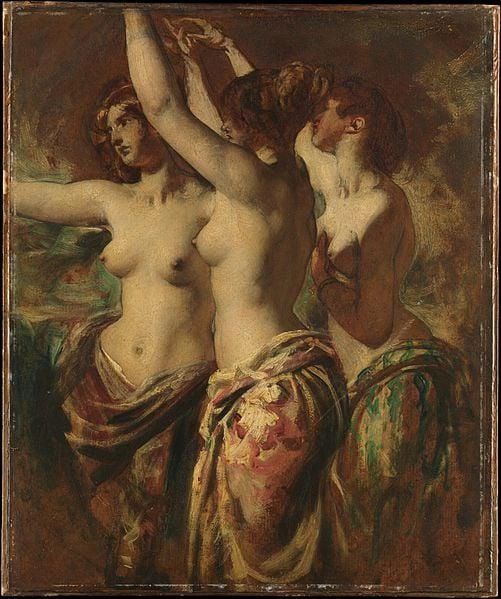

Hand painted reproductions of William Etty
William Etty: The Master of the Human Form in British Art
William Etty (1787–1849) was a British painter renowned for his mastery of the human figure, particularly his depictions of nudes within historical and mythological settings. As one of the most significant artists of the English Romantic era, Etty's work combined rich color palettes, dramatic compositions, and a deep appreciation for the beauty of the human body. His paintings remain a cornerstone of 19th-century British art, celebrated for their technical brilliance and sensual elegance.
Early Life and Education
Born in 1787 in York, England, William Etty showed an early interest in drawing but initially pursued a trade as a printer’s apprentice. His passion for art eventually led him to London, where he enrolled at the Royal Academy Schools in 1807. Under the mentorship of Sir Thomas Lawrence, one of the leading portrait painters of the time, Etty honed his skills in color and composition.
Etty was deeply influenced by the Old Masters, particularly Titian, Rubens, and Veronese. He spent time in Italy studying Renaissance and Baroque paintings, which helped him develop his signature style—characterized by luminous flesh tones and dramatic contrasts of light and shadow.
Artistic Development and Style
William Etty’s art is distinguished by his ability to capture the human form with extraordinary precision and sensitivity. Unlike many of his contemporaries, who focused on landscapes or grand historical themes, Etty specialized in figure painting, often portraying mythological or allegorical subjects.
One of his most famous works, The Combat: Woman Pleading for the Vanquished, showcases his mastery of anatomy and movement. The painting’s rich colors, dynamic composition, and expressive figures demonstrate Etty’s ability to bring classical themes to life with emotional depth.
Despite his technical brilliance, Etty’s focus on the nude figure was controversial in Victorian England, where prudish attitudes toward the human body often led to criticism of his work. Nevertheless, he remained committed to his artistic vision, believing that the human form was the highest expression of beauty in art.
Themes and Significance
Etty’s paintings often explored themes of heroism, morality, and the transient nature of beauty. His works drew from classical mythology, literature, and biblical stories, emphasizing the contrast between virtue and vice, innocence and temptation.
In addition to his historical and allegorical compositions, Etty also painted portraits and still lifes, showcasing his versatility as an artist. However, his true passion remained in celebrating the human body, which he depicted with both realism and idealization.
Achievements and Influence
Throughout his career, William Etty exhibited extensively at the Royal Academy, gaining recognition as one of Britain’s leading painters. In 1828, he became a full member of the Academy—a testament to his artistic accomplishments and influence.
Despite facing criticism from conservative critics, Etty’s dedication to the human figure inspired later generations of artists, including the Pre-Raphaelites, who admired his use of color and commitment to classical ideals. His influence can also be seen in the works of John William Waterhouse and other Victorian-era painters who embraced themes of mythology and romanticism.
Legacy
William Etty’s legacy endures as a master of figurative painting, bridging the traditions of the Old Masters with the emerging sensibilities of the 19th century. His ability to render the human body with both sensuality and dignity set him apart from his contemporaries and solidified his place in British art history.
Today, Etty’s paintings are housed in prestigious collections, including the Tate Britain and the York Art Gallery, which holds the largest collection of his works. His art continues to be appreciated for its technical excellence, emotional depth, and celebration of classical beauty.
Where to Find Reproductions of William Etty’s Art
For those who wish to own a piece of William Etty’s timeless artistry, POD (Painting On Demand) offers high-quality reproductions of his masterpieces. These reproductions allow collectors to experience the richness of Etty’s work, making them a valuable addition to any classical art collection.
William Etty’s paintings stand as a tribute to the enduring beauty of the human form, combining historical grandeur with an unmatched sensitivity to color and composition. His work remains a source of inspiration for art lovers and historians alike, ensuring his place among the great masters of British art.
Imagine owning an original work of art by William Etty, one of the greatest artists in history. At POD we offer you the opportunity to make this dream come true. We reproduce William Etty's works down to the smallest detail, so you can enjoy them in your own home.
Our reproductions are made by experienced artists who use the best materials and techniques. We are dedicated to providing you with the highest quality works of art, which will bring joy and inspiration to your family for generations.





